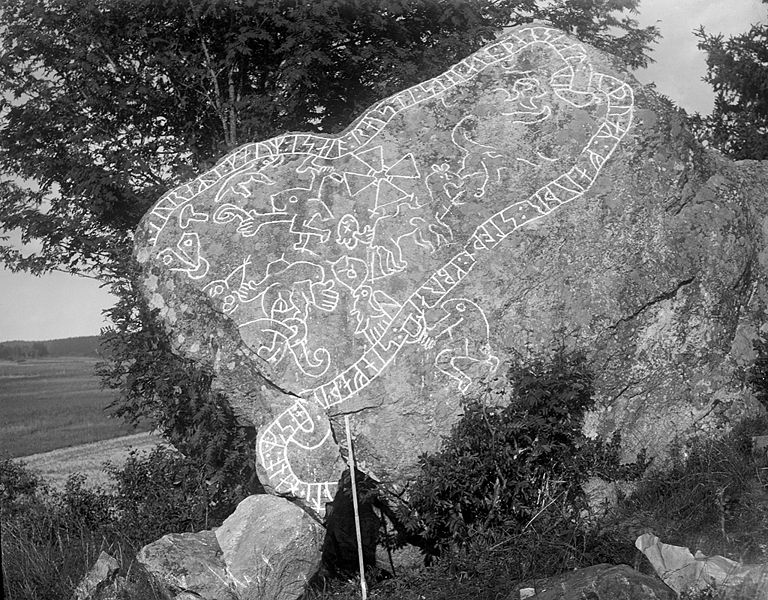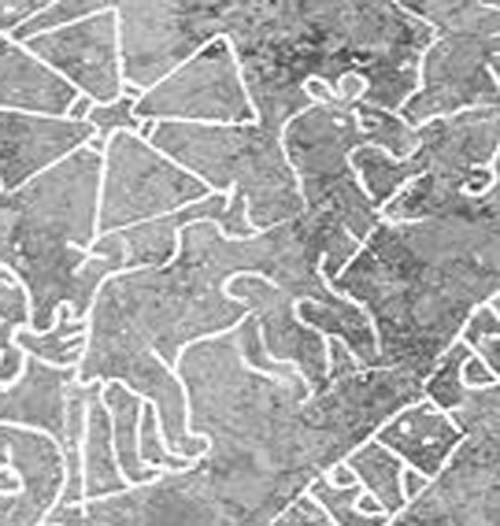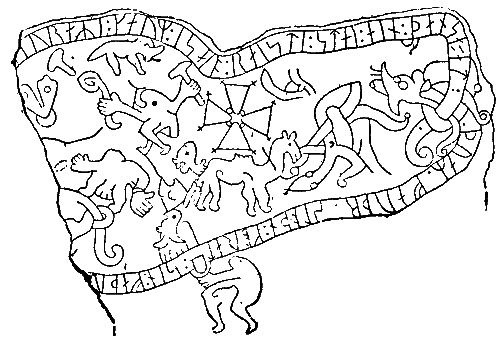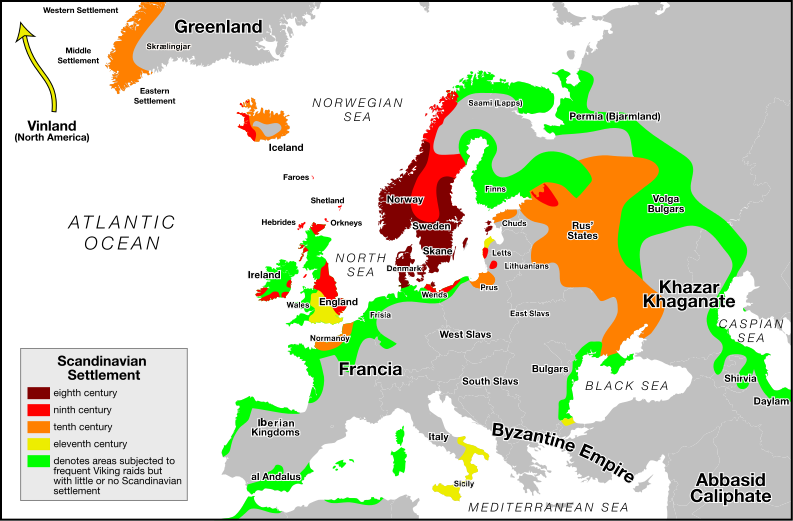It looks like you're using an Ad Blocker.
Please white-list or disable AboveTopSecret.com in your ad-blocking tool.
Thank you.
Some features of ATS will be disabled while you continue to use an ad-blocker.
share:
I found this picture from 1922 of Gökstenen - a Swedish runestone from the district of Härad. What is funny is that it clearly depicts a
dromedary, which is a desert animal native to northern Africa and far awy from Northern Europe.
Somewhere in our forgotten past a Viking lord saw a dromedary on one of his travels and decided to conmemorate it in this stone 1,000+ years ago - my
mind boggles.
Gökstenen rune stone (photo taken in 1922):

Magnification:


Source
-MM
Gökstenen rune stone (photo taken in 1922):

Magnification:


Runic inscription Gökstenen (Sö 327) on boulder in Härad dated from about the year 1,000 CE. The images on the boulder are from the Old Norse Sigurd Saga. The meaning of the runes is uncertain and difficult to interpret. The interpretation by Säve says: "Iasio raised the stone, by himself, in memory of Thuar, father Slodes, and Brand, his father...(carved the runes) Iurar in Kaum".
Source
-MM
edit on 16-8-2014 by MerkabaMeditation because: (no reason given)
a reply to: MerkabaMeditation
i cant really make it out in the pic, but your mind only boggles as you don't know much about the old Norse.
They travelled widely over a thousand years ago, founded "Russia" dealt widely with Byzantium and the Arabs and buried huge caches of Arabian silver.
Many Vikings would have been in North Africa, The Levant or Byzantium and had a chance to see them.... Harald Hardrada (he of Stamford Bridge fame) was a Varangian Guard to the rulers of Byzantium iirc.
I know i sound an ass, but reading history commonly clears up this kind of stuff.
i cant really make it out in the pic, but your mind only boggles as you don't know much about the old Norse.
They travelled widely over a thousand years ago, founded "Russia" dealt widely with Byzantium and the Arabs and buried huge caches of Arabian silver.
Many Vikings would have been in North Africa, The Levant or Byzantium and had a chance to see them.... Harald Hardrada (he of Stamford Bridge fame) was a Varangian Guard to the rulers of Byzantium iirc.
I know i sound an ass, but reading history commonly clears up this kind of stuff.
a reply to: skalla
I've added some maginfications. I'm very much aware of their travels and still my mind boggles of what these people were capable of
Here is a map of where the vikings went:

-MM
I've added some maginfications. I'm very much aware of their travels and still my mind boggles of what these people were capable of
Here is a map of where the vikings went:

-MM
edit on 16-8-2014 by MerkabaMeditation because: (no reason given)
In this case though it's actually just a horse with a carrier bag or saddle attached to it's back, it's clearly shown in the drawing in the link of
OP.
It's a different stone but the same story told.
It's a different stone but the same story told.
edit on 16-8-2014 by Mianeye because: (no reason given)
a reply to: MerkabaMeditation
Yep the Norse were way cool, but considering how much is really, really well documented by contemporary writings, the Sagas (iirc, and it's been a long time but Harald's Saga covers his time in Byzantium) and thousands of finds, it ain't surprising that they would have seen a camel.
Lovely rune stone though, The Story of Sigurd and Fafnir/The Volsung saga is a real favourite of mine.
Yep the Norse were way cool, but considering how much is really, really well documented by contemporary writings, the Sagas (iirc, and it's been a long time but Harald's Saga covers his time in Byzantium) and thousands of finds, it ain't surprising that they would have seen a camel.
Lovely rune stone though, The Story of Sigurd and Fafnir/The Volsung saga is a real favourite of mine.
originally posted by: Mianeye
In this case though it's actually just a horse with a carrier bag or saddle attached to it's back, it's clearly shown in the drawing in the link of OP.
The horse in the first images of the link is from some other rune stone. There are many rune stones depicted in that link and not just Gökstenen.
-MM
edit on 16-8-2014 by MerkabaMeditation because: (no reason given)
a reply to: MerkabaMeditation
Really cool stuff. This was for me first time I've heard and seen vikings putting such a direct references to animals from other regions - into their runes. But, as seen here, did happen.
Agreeing, its a mind boggling to realize these vikings were having trade routes and frequent travels much around the same regions as their current descendant Scandinavians would do. I.e. visiting Black Sea beaches, Istanbul (Constantinoble), Spain, Portugal, North Africa ... Trading back and forth. And all this 800 - 1100 AD.
Again a reminder of humanity being much more resourceful and more innovative than we might today believe from it.
Really cool stuff. This was for me first time I've heard and seen vikings putting such a direct references to animals from other regions - into their runes. But, as seen here, did happen.
Agreeing, its a mind boggling to realize these vikings were having trade routes and frequent travels much around the same regions as their current descendant Scandinavians would do. I.e. visiting Black Sea beaches, Istanbul (Constantinoble), Spain, Portugal, North Africa ... Trading back and forth. And all this 800 - 1100 AD.
Again a reminder of humanity being much more resourceful and more innovative than we might today believe from it.
I seem to remember for about 200 years the norse used Damascus steel for the well off Vikings weapons.
Pbs special on it I think is what I watched.
Pbs special on it I think is what I watched.
a reply to: MerkabaMeditation
Yes, but it's the same story told, so it's still a horse.
Edit in above post.
Yes, but it's the same story told, so it's still a horse.
Edit in above post.
a reply to: Mianeye
Might be just a poorly drawn horse, I don't know really. Still, looks like a dromedary to me, so who knows. Perhaps it originally was a dromedary than later runes changed it to a horse, no one knows really as the age of runes are difficult to date. The Gökstenen rune stone has an older apperance - to me that is - than your rune stone.
-MM
Might be just a poorly drawn horse, I don't know really. Still, looks like a dromedary to me, so who knows. Perhaps it originally was a dromedary than later runes changed it to a horse, no one knows really as the age of runes are difficult to date. The Gökstenen rune stone has an older apperance - to me that is - than your rune stone.
-MM
edit on 16-8-2014 by MerkabaMeditation because: (no reason given)
a reply to: MerkabaMeditation
I have tried to translate the story from several sites now, but they all come out bad, so i suggest you google it and it might be translated the right way.
Or try translate this link, that have a small notice on the stones.
CLICK ME
Fixed it, not the best.
I have tried to translate the story from several sites now, but they all come out bad, so i suggest you google it and it might be translated the right way.
Or try translate this link, that have a small notice on the stones.
CLICK ME
Fixed it, not the best.
Ramsundsristningen, Swedish rune-and image carving from the beginning of 1000 t. near Eskilstuna. The almost 5 meters wide toasting with episodes from the legend of Sigurd found on a large glacial near the bridge as Sigrid according to the inscription did do for her husband's soul. There are several known contemporary representations of Sigurd myth; a closely related are the Gökstenen in the same area.
edit on 16-8-2014 by Mianeye because: (no reason given)
a reply to: MerkabaMeditation
The Vikings were the first gonzo reporters, predating Hunter S Thompson by thousands of years. They'd load up on boats, eat some questionable mushrooms, and tour the deserts and oceans of the world. Then they'd go back home and write about it.
Fear and Boating Lost Valhalla
The Vikings were the first gonzo reporters, predating Hunter S Thompson by thousands of years. They'd load up on boats, eat some questionable mushrooms, and tour the deserts and oceans of the world. Then they'd go back home and write about it.
Fear and Boating Lost Valhalla
a reply to: MerkabaMeditation
That one looks like a board game to me. Are they sure some of them aren't just games created to entertain the kids?
Are there any old dice nearby?
That one looks like a board game to me. Are they sure some of them aren't just games created to entertain the kids?
Are there any old dice nearby?
edit on 16-8-2014 by rickymouse because: (no reason given)
a reply to: Mianeye
The depicted animal is called Grane. Might have been some other animal than a horse in more ancient viking times though - like a dromedary. They may have changed the story when people forgot the true animal - mythological stories do that all the time. I agree with you that todays interpretation of Grane was that it was a horse though.
-MM
The depicted animal is called Grane. Might have been some other animal than a horse in more ancient viking times though - like a dromedary. They may have changed the story when people forgot the true animal - mythological stories do that all the time. I agree with you that todays interpretation of Grane was that it was a horse though.
-MM
edit on 16-8-2014 by MerkabaMeditation because: (no reason given)
originally posted by: Cuervo
a reply to: MerkabaMeditation
The Vikings were the first gonzo reporters, predating Hunter S Thompson by thousands of years. They'd load up on boats, eat some questionable mushrooms, and tour the deserts and oceans of the world. Then they'd go back home and write about it.
Fear and Boating Lost Valhalla
Ah, yes... The BESERKERS. Naked warriors that got high on mushrooms and killed everything in sight - sometimes even their own men if they got too close to them in the fury of battle. Those where the days...
-MM
edit on 16-8-2014 by MerkabaMeditation because: (no reason given)
originally posted by: rickymouse
a reply to: MerkabaMeditation
That one looks like a board game to me. Are they sure some of them aren't just games created to entertain the kids?
Are there any old dice nearby?
No, the snake shapes with lines going along it, is definitely written text.

Another thing; the "sun cross" symbol above is quite similar to:
Representing Mount Meru in India/Tibet

Celtic Templar Cross

(Thanks to Zorgon for the images)
-MM
edit on 16-8-2014 by MerkabaMeditation because: (no reason given)
a reply to: MerkabaMeditation
Ah something new and all well covered by Skalla and the others.
The Vikings were a dynamic people and if you have the opportunity I can personally recommend going to these six museums.
The Birka Museum in Stockholm, Sweden
Oslo's Viking Ship Museum, Norway
Lofotr Vikingmuseumm, Vestvågöy Norway,
Ribe, Denmark (Viking town reconstructed)
The Viking Ship Museum, Roskilde, Denmark
Oh and while you're in Oslo you might want to visit Thor Heyerdahl's museum, he was sometimes described as the 'last Viking'.
Ah something new and all well covered by Skalla and the others.
The Vikings were a dynamic people and if you have the opportunity I can personally recommend going to these six museums.
The Birka Museum in Stockholm, Sweden
Oslo's Viking Ship Museum, Norway
Lofotr Vikingmuseumm, Vestvågöy Norway,
Ribe, Denmark (Viking town reconstructed)
The Viking Ship Museum, Roskilde, Denmark
Oh and while you're in Oslo you might want to visit Thor Heyerdahl's museum, he was sometimes described as the 'last Viking'.
Here is the translation, depicted is the Sigurd Saga and yes the 'dromedary' is Grani the horse, though
as has been said already, in antiquity it could have been a dromedary.
www.flickr.com...
www.flickr.com...
Runic boulder Gökstenen (Cuckoo Stone), Härad, Södermanland, Sweden
Runic inscription Gökstenen (Cuckoo Stone) (Sö 327) on boulder in Härad. The images on the boulder are from the Old Norse Sigurd Saga. The meaning of the runes is uncertain and difficult to interpret. The interpretation by scientist Säve says: "Iasio raised the stone, by himself, in memory of Thuar, father Slodes, and Brand, his father...(carved the runes) Iurar in Kaum".
edit on 16-8-2014 by theabsolutetruth because: (no reason given)
new topics
-
Joe Rogan conspiracy (maybe)
ATS Skunk Works: 2 hours ago -
Results of the use of the Oreshnik missile system in Dnepropetrovsk
World War Three: 5 hours ago -
Nigel Farage now the Most Favoured UK Politician
Regional Politics: 6 hours ago
top topics
-
Little Johnny and Larry should team up
General Chit Chat: 12 hours ago, 10 flags -
Results of the use of the Oreshnik missile system in Dnepropetrovsk
World War Three: 5 hours ago, 10 flags -
Nigel Farage now the Most Favoured UK Politician
Regional Politics: 6 hours ago, 3 flags -
Will Us use alien technology to fight in ww3?
World War Three: 13 hours ago, 2 flags -
Joe Rogan conspiracy (maybe)
ATS Skunk Works: 2 hours ago, 2 flags
active topics
-
DOJ moving to wind down Trump criminal cases before he takes office
Mainstream News • 44 • : WeMustCare -
Results of the use of the Oreshnik missile system in Dnepropetrovsk
World War Three • 128 • : WeMustCare -
President-Elect DONALD TRUMP's 2nd-Term Administration Takes Shape.
Political Ideology • 240 • : WeMustCare -
Nigel Farage now the Most Favoured UK Politician
Regional Politics • 6 • : angelchemuel -
President-Elect TRUMP Picks Former Florida A.G. PAM BONDI to be U.S. Attorney General.
2024 Elections • 56 • : VariedcodeSole -
Well we know Putins ICBMs won't fail in their silos
World War Three • 209 • : Xtrozero -
Jaguar Rebrand Video Causes "WTF?" Moment - Seriously Weird
Automotive Discussion • 26 • : angelchemuel -
Post A Funny (T&C Friendly) Pic Part IV: The LOL awakens!
General Chit Chat • 7815 • : baddmove -
Joe Rogan conspiracy (maybe)
ATS Skunk Works • 2 • : watchitburn -
Little Johnny and Larry should team up
General Chit Chat • 3 • : bluesman023

